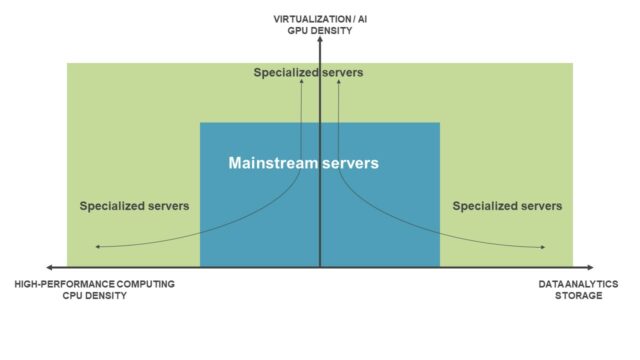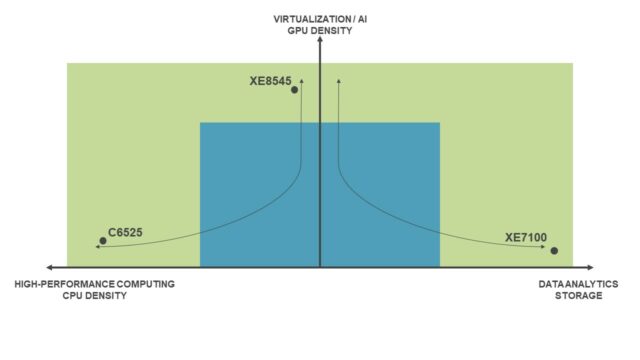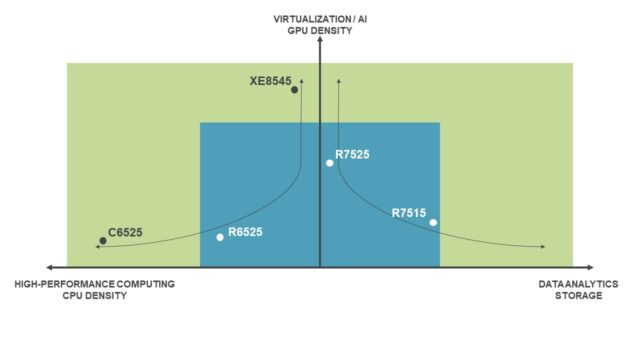Selecting the right server for your IT infrastructure can feel like selecting the best produce at the grocery store. There are some clear losers, but when selecting the best avocado, I sometimes feel the need to consult a fortune teller. After moving past the bruised selection, which one is best for toast or as a burger topping? Will it be ripe tomorrow or in three days? How long do I have until it needs to be mashed into guacamole?
Selecting the right servers feels the same. There are pretty clear upfront winners and losers: yes for GPUs, no for single-socket, must be a 2U. But what is right for my current applications as well as updates over the next year and whatever comes in the next 3-5? When looking at an individual application in your vast data center deployment, the answer can become drowned out by the noise of the greater system requirements.
Luckily, Dell is playing the role of grocer and learning some best practices from our customers. When it comes to hardware selection, you have shown us that there are three clear differentiators: specializing in data analytics, high-performance computing, and a combination of virtualization and AI.
In terms of hardware components, this divergence represents a tradeoff between CPU density, GPU density, and storage. These components relate to HPC, virtualization/AI, and data analytics respectively. Further, the research shows that CPU density and storage are opposing components. In simpler terms, HPC sacrifices storage for the sake of CPU density, and data analytics workloads sacrifice CPU density for storage.
 To put this in a concrete example, our C6525 is highly specialized in HPC, the XE7100 in data analytics, and the XE8545 in artificial intelligence. Dell’s other PowerEdge servers are sprinkled evenly across this framework; none overachieving in any two specializations. You will also notice that because a server is highly specialized does not mean it does not contain aspects of the other two workload components. However, the main trait does overshadow the other two:
To put this in a concrete example, our C6525 is highly specialized in HPC, the XE7100 in data analytics, and the XE8545 in artificial intelligence. Dell’s other PowerEdge servers are sprinkled evenly across this framework; none overachieving in any two specializations. You will also notice that because a server is highly specialized does not mean it does not contain aspects of the other two workload components. However, the main trait does overshadow the other two:
-
- C6525 – 4x 64-core AMD Milan CPUs in a 2U with 6 drives per node
- XE7100 – 100x toolless drive carriers with 2 Intel Xeon per node
- XE8545 – 4x 500W A100 GPUs in an air-cooled environment
 Your next question may be, “What about the other components? Having fast memory is incredibly important to my applications.” You are not wrong. The reason memory and IOPS don’t make a major appearance is because they are important across all workloads at varying degrees. They are important, just not a top three differentiator.
Your next question may be, “What about the other components? Having fast memory is incredibly important to my applications.” You are not wrong. The reason memory and IOPS don’t make a major appearance is because they are important across all workloads at varying degrees. They are important, just not a top three differentiator.
This finding has some significant implications for your data center. To optimize the performance of your applications it makes sense to pair your applications with a cluster of servers that are best suited for the software requirements. In a recent IDC study, they found just this. It is better to purchase servers that are fit-for-purpose and leave less strenuous and less critical applications to cloud providers. By using this fit-for-purpose strategy you can improve performance and scalability for your business critical and emerging workloads.
For many of our customers, it may not make sense to buy these super specialized servers for their data centers. This is why Dell Technologies builds our servers along the spectrum of specialization. Consider where the PowerEdge with AMD rack portfolio falls on this framework. Depending on of your workload requirements you could build multiple clusters for the different parts of your business. This operational strategy could increase your performance and productivity for applications and software engineers.
 All this being said, server selection is still just as much an art as it is a science. There are many data center requirements that fall outside of the internal hardware components. System management, security, and financing options all play a crucial role in what works best for your data center. However, this framework can be used as a simple tool for starting your selection process. To find out more about the complete server selection process please read the full IDC study on fit-for-purpose infrastructure.
All this being said, server selection is still just as much an art as it is a science. There are many data center requirements that fall outside of the internal hardware components. System management, security, and financing options all play a crucial role in what works best for your data center. However, this framework can be used as a simple tool for starting your selection process. To find out more about the complete server selection process please read the full IDC study on fit-for-purpose infrastructure.
